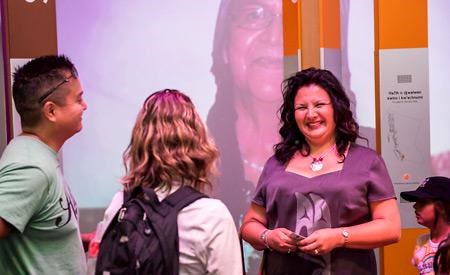A recently opened exhibition in Victoria is celebrating BC’s rich diversity of First Nation languages and is helping to tell a remarkable tale of resilience in the face of change.
Our Living Languages: First Peoples’ Voices in BC officially opened June 21 at the Royal BC Museum to coincide with National Aboriginal Day. The exhibit, which runs until 2017, was made possible through a partnership between the museum and the First Peoples’ Cultural Council, a BC Crown corporation mandated to support first nations in their efforts to revitalize their languages, arts, culture and heritage.
BC is widely regarded as a linguistic hotspot in the world with 34 unique First Nation languages and 61 dialects. In past decades though, the vitality of these languages has been threatened in communities here, as they have been around the world.
Our Living Languages explores and explains how culture is inextricably linked to language and how First Nation language activists have ensured languages are kept alive for future generations of speakers.
One of those activists is Tla’amin (Sliammon) Nation’s Siemthlut (Michelle Washington) whose family has been working to promote and safeguard its native tongue for generations. Her grandparents, former Chief Bill and Rose Mitchell, worked together with ethnographers and linguists Randy Bouchard and Dorothy Kennedy to write Sliammon Life, Sliammon Lands, published in 1983 by Talonbooks. Before that, her great-grandfather Johnny Dominick helped American anthropologist Homer Barnett with his research of Coast Salish peoples in the 1950s. Siemthlut’s mother taught language at James Thomson Elementary School for almost 25 years.
“Generationally, my family has tried to share our language and culture and archive and document it for future generations,” she said. “I feel like I’m continuing what they started.”
As language exhibition manager for the cultural council, she has worked with a committee of language and culture consultants from first nations around the province to develop the exhibit.
“It really depicts our cultures as living—other museums around the world show cultures locked in showcases,” said Siemthlut, explaining that the exhibit is interactive and gives visitors both an audio and video experience.
The whole exhibit fits into about 3,000 square feet at the museum and highlights the diversity, disruptions, resilience and renewal of indigenous languages.
“You can imagine how difficult it is to fit 34 languages into such a small space,” Siemthlut said. She and her team have worked to strike a balanced representation of all language groups. Tla’amin fits into the Salishan language group.
In the exhibit visitors will learn about the diversity of languages. Siemthlut believes that at least part of the reason for the number of unique languages has to do with BC’s geography which can isolate groups.
A welcome forest in the exhibit gives visitors the chance to learn greetings in all 34 languages, she said.
“Most people in BC don’t know a lot about the languages of the people whose territory they live and work in,” she said. The exhibit also gives visitors the chance to learn some basic vocabulary about local plants and animals.
The difficult part of putting together an exhibit like this was that most of the languages require different orthographic symbols to represent unique sounds in those languages, Siemthlut explained.
There are two walls with large projections of language champions, aboriginal people who have devoted themselves, like Siemthlut, to the preservation of their languages and cultures. An interactive map in the exhibit gives visitors the chance to visualize where particular languages are spoken and provides current statistics for the number of speakers there are of particular languages.
Siemthlut’s favourite part of the exhibit is what she calls the cradle of language. Visitors are greeted by an unfinished woven baby basket and are asked to let the sounds in the room just wash over them, she said.
“Five different nations are represented there,” she said, “with sounds a baby would hear from the cradle.”
Neither translation nor visual cues are provided, she added. “It’s just meant for people to hear and feel.”
Resilience and renewal of the languages are a key theme for the exhibit. Siemthlut said the culture and language committee has tried to not put too much of the exhibit’s focus on the threats to indigenous languages, preferring to highlight the work of committed people on building and strengthening.
The reason for the dramatic decline in the numbers of speakers of these languages is clear though, she said, citing more than 100 years of government assimilation policies, residential schools and exclusion of aboriginal languages in daily life.
“A lot of people don’t realize that a lot of those assimilation policies are not ancient history—the last residential school only closed in 1996,” she added.
Throughout the exhibit there are videos which tell the story about how people are facing the challenge of revitalizing their languages.
One effort, First Voices, which includes Tla’amin, has used emerging web and smartphone technology to promote languages. Twenty-five are included in the program and give users dictionaries, language learning games, and even an instant message application where users can “chat” with their traditional languages.
Despite the fact the exhibit will run for three years, Siemthlut said it will not remain static and there will be room for groups to give visitors language workshops, presentations and performances.
She said when this exhibit winds up she hopes the museum will continue to showcase the non-tangible aboriginal culture, maybe highlighting First Nation music.
Siemthlut encourages everyone to visit the exhibition to better understand first nations’ culture. “When we go anywhere in the world, the first thing we do is try to learn a little about the language and culture of the people to show respect,” she said.
Tickets for Our Living Languages are available online or at the Royal BC Museum Box Office. For more information, readers can visit royalbcmuseum.bc.ca or call 1.877.447.7977.



